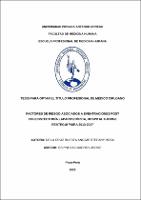| dc.contributor.advisor | Espinoza Cuadros, Jorge | |
| dc.contributor.author | De la Cruz Ruesta, Anggie Stefany Rosa | |
| dc.creator | De la Cruz Ruesta, Anggie Stefany Rosa | |
| dc.date.accessioned | 2020-12-02T23:33:43Z | |
| dc.date.available | 2020-12-02T23:33:43Z | |
| dc.date.issued | 2020 | |
| dc.identifier.uri | https://hdl.handle.net/20.500.12759/6891 | |
| dc.description.abstract | Objetivo: Conocer cuáles son los factores asociados a eventraciones por orificio de
trocar en 5 años post técnica quirúrgica de colecistectomía laparoscópica, en el
Hospital II EsSalud Jorge Reátegui Delgado, Enero del 2013 a Diciembre del 2017.
Material y método: Estudio descriptivo, retrospectivo, de fuentes secundarias de
corte transversal. Se realizó a una Población. - Constituida por los pacientes
diagnosticados de eventración post colecistectomía laparoscópica en el Hospital
Jorge Reátegui Delgado, durante el periodo de Enero del 2013 – Diciembre del
2017. Resultados: Se registraron 1265 pacientes con colecistectomía
laparoscópica de los cuales 7 (0,55%) presentaron eventración por orificio de trocar
post quirúrgica, predominando las eventraciones por trocar a nivel umbilical con un
porcentaje de 71,4%. El sexo que sobresalió con un porcentaje de 84,71% fue el
sexo femenino. En relación a los rangos de edades, el de mayor frecuencia se
evidenció entre los 48 a 53 años. El Índice de Masa Corporal (IMC) entre 25.0 a
29.9 obtuvo un porcentaje significativo de 57.14%. La Obesidad (IMC >30 kg/m2
)
constituye la comorbilidad más frecuente con un 42.85%, seguido de la hipertensión
arterial y Diabetes Mellitus tipo 2 con un 28.57% y 14.28% respectivamente. En
cuanto a la técnica quirúrgica, las causas que se relacionaron fueron la colocación
de 4 puertos con una técnica de dos trocares de 5 mm y dos de 10 mm, y el haber
utilizado sutura con Ácido Poliglicólico N°0 en un tiempo operatorio de 120 minutos
(71,14%) por cirugía. El intervalo entre la operación y el diagnóstico de eventración
en orificio de trocar (EOT) fue de 9 a 15 meses representando un porcentaje de 57,
14%. Conclusiones: Los factores asociados a la eventración por orificio de trocar
en el seguimiento a 5 años post colecistectomía laparoscópica en el Hospital Jorge
Reátegui Delgado, fue la técnica de 4 puertos con utilización de dos trocares de 5
mm y dos de 10 mm asociado a sutura con Ácido Poliglicólico N° 0. | es_PE |
| dc.description.abstract | Objective: To know the factors associated with trocar hole hernias in 5 years after
laparoscopic cholecystectomy surgical technique, at Hospital II EsSalud Jorge
Reategui Delgado, January 2013 to December 2017. Material and method: A
descriptive, retrospective study of cross-sectional secondary sources. It was carried
out to a Population. - Constituted by patients diagnosed with post laparoscopic
cholecystectomy eventration at the Jorge Reategui Delgado Hospital, during the
period of January 2013 - December 2017. Results: 1265 patients with laparoscopic
cholecystectomy were registered, of which 7 (0.55%) had postoperative trocar orifice
herniation, of which trocar herniation predominated at the umbilical level with a
percentage of 71.4%. According to the sex that predominated with 84.71% it was
the female sex. In relation to age ranges, the most frequent was between 48 to 53
years. The Body Mass Index (BMI) between 25.0 to 29.9 obtained a significant
percentage of 57.14%. Obesity (BMI> 30 kg / m2) constitutes the most frequent
comorbidity with 42.85%, followed by arterial hypertension and type 2 Diabetes
Mellitus with 28.57% and 14.28% respectively. Regarding the surgical technique,
causes that were related were the placement of 4 ports with a technique of two 5
mm and two 10 mm trocars, and having used a suture with Polyglycolic Acid No. 0
in an operative time of 120 minutes (71.14%) due to surgery. The interval between
the operation and the diagnosis of trocar hole involvement (TOT) was 9 to 15
months, representing a percentage of 57.14%. Conclusions: Factors associated
with trocar hole involvement (TOT) in the 5-year follow-up after laparoscopic
cholecystectomy at Jorge Reátegui Delgado Hospital, was the 4 ports technique
using two 5-mm trocars and two of them. 10 mm associated with suture with
Polyglycolic Acid No. 0 suture. | en_US |
| dc.description.uri | Tesis | es_PE |
| dc.format | application/pdf | es_PE |
| dc.language.iso | spa | es_PE |
| dc.publisher | Universidad Privada Antenor Orrego | es_PE |
| dc.relation.ispartofseries | T_MEDP_234 | |
| dc.rights | info:eu-repo/semantics/openAccess | es_PE |
| dc.rights.uri | https://creativecommons.org/licenses/by/4.0/ | es_PE |
| dc.source | Universidad Privada Antenor Orrego | es_PE |
| dc.source | Repositorio Institucional - UPAO | es_PE |
| dc.subject | Eventración por orificio de trocar | es_PE |
| dc.subject | Colecistectomía laparoscópica | es_PE |
| dc.subject | Eventración umbilical | es_PE |
| dc.title | Factores de riesgo asociados a eventraciones post colecistectomía laparoscópica, Hospital II Jorge Reátegui Piura 2013-2017 | es_PE |
| dc.type | info:eu-repo/semantics/bachelorThesis | es_PE |
| thesis.degree.level | Título Profesional | es_PE |
| thesis.degree.grantor | Universidad Privada Antenor Orrego. Facultad de Medicina Humana | es_PE |
| thesis.degree.name | Médico Cirujano | es_PE |
| thesis.degree.discipline | Medicina Humana | es_PE |
| dc.subject.ocde | https://purl.org/pe-repo/ocde/ford#3.02.27 | es_PE |
| renati.author.dni | 77338151 | |
| renati.type | https://purl.org/pe-repo/renati/type#tesis | es_PE |
| renati.level | https://purl.org/pe-repo/renati/level#tituloProfesional | es_PE |
| renati.discipline | 912016 | es_PE |
| dc.publisher.country | PE | es_PE |


